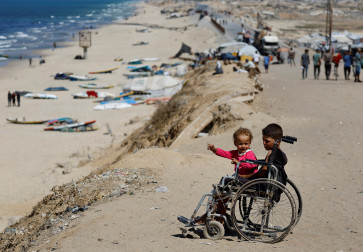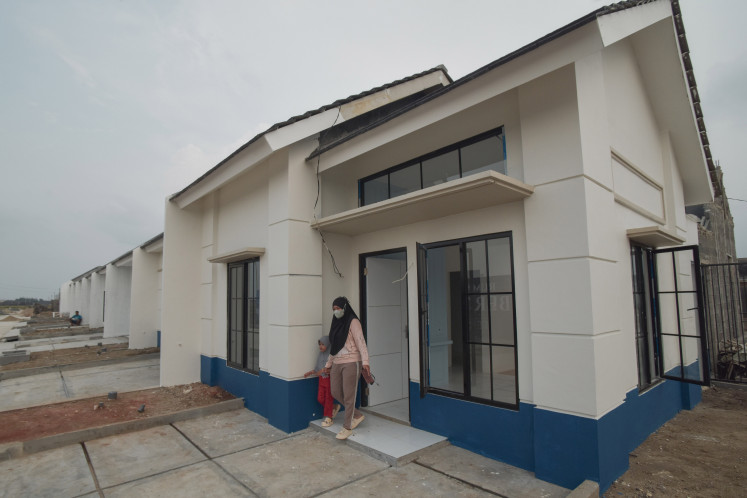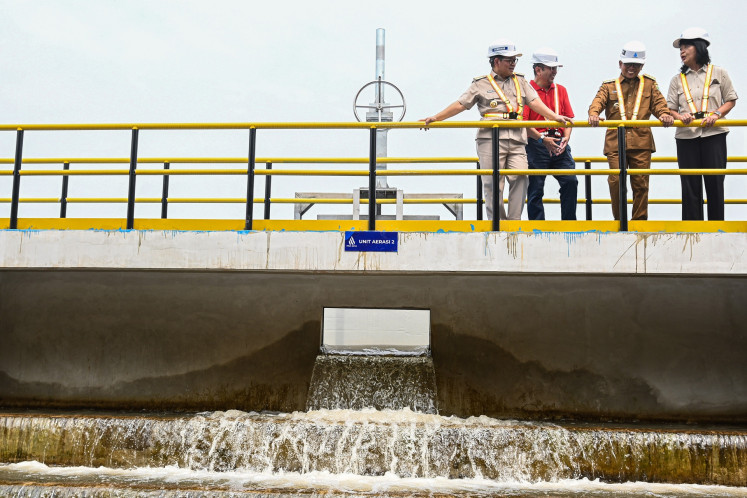Popular Reads
Top Results
Can't find what you're looking for?
View all search resultsPopular Reads
Top Results
Can't find what you're looking for?
View all search resultsBatin Sembilan tribe sticks to nomadic life
It was late afternoon on Thursday when The Jakarta Post finally met up with a semi-nomadic family in Harapan, a rainforest cluster located on the border of Jambi and South Sumatra
Change text size
Gift Premium Articles
to Anyone
I
t was late afternoon on Thursday when The Jakarta Post finally met up with a semi-nomadic family in Harapan, a rainforest cluster located on the border of Jambi and South Sumatra.
Muhamat, also known as Mat Attam, 35, and his 12-year-old daughter Siti are descendants of Mat Liar of the Batin Sembilan tribe, the indigenous people who have lived and moved around deep in the forest since the Dutch colonial era.
Although the forest, covering about 100,000 hectares across four regencies in the provinces, is now restored and managed by PT Restorasi Ekosistem Indonesia (Reki), its people are still allowed to live in it.
The Mat Liar group is among the few tribe members that still has not adopted modern life and remains in the heart of the forest. They reportedly comprise only 20 to 30 people. To meet them, the Post had to travel 60 kilometers from the nearest company office in Bungku village, Batanghari regency, Jambi.
That afternoon, Muhamat and Siti were sitting in a transit hut in Soko Suban village, Musi Banyuasin regency, South Sumatra.
They had just bartered 1 kilogram of jernang (dragon’s blood) powder, a type of resin extracted from palm rattan, with a local trader. It is commonly used for medicines as well as for producing incense, perfume and as a coloring agent.
In a peculiar dialect of Malay, Muhamat said it was the result of five’s day work in the forest. He usually bartered once a week. “We will go back to the forest tonight,” he added.
For the jernang powder that he bartered that day Muhamat received rice, sugar, salt, coffee and cigarettes worth about Rp 600,000 (US$42) in return. All are daily necessities they cannot get in the forest. For food, they usually catch fish in the river or hunt animals in the forest.
A total of about 220 families, which make up the Batin Sembilan tribe, have been registered in the Harapan restoration area, which covered 52,170 ha in Jambi and 46,385 in South Sumatra, according to the forest’s head of stakeholder partnership and stabilization division, Adam Aziz.
While most of them live on the outskirts of the forests, those who live a nomadic life are the most difficult to get in touch with.
“Their semi-nomadic way of life makes it difficult for us to meet them and collect data,” Adam said.
Mat Tanding, a Batin Sembilan tribe member who has settled near Reki’s Batanghari camp, said nomads like the Mat Liar group hardly communicated with the outside world.
“Many of them cannot speak Malay. They murmur when speaking,” he said.
The ancestors of the nomadic Batin Sembilan are believed to have fled deep into the forest to escape war during Dutch occupation.They have not kept pace with the outside world and many do not know who the current president is.
Even Mat Tanding, who left the nomadic life, could not name the current president — much like Muhamat.
Reki has so far succeeded in getting three groups of such communities to sign a forestry partnership agreement with the company to plant crops and develop agroforestry. They are the Tanding group with 17 members, Gelinding with 10, and Lamban Jernang with 23.
“Empowering them is important considering their ability to only exploit non-wood forest products such as sap, resin, jernang, honey as well as hunting for animals,” Adam said.
Harapan is a pilot project to restore ecosystems involving many parties. It was launched in 2007, followed by another project in Bukit Tigapuluh National Park in 2014.
In Bukit Tigapuluh, 55 families of the Talang Mamak tribe have also settled in a restoration area managed by PT Alam Bukit Tigapuluh (ABT) in Semerantihan village, Tebo regency, Jambi. Another 398 families of the the Rantau Langsat group have also settled in another part of the national park in Riau.
To get to Semerantihan, one has to cross the Sekalo and Semerantihan rivers as both have no bridges. The Sekalo River initially had one but it was destroyed in 2010 because the tribe wanted to stop illegal logging practices in the area.
The asphalt road ends in Suo Suo subdistrict, some 8 km from Semerantihan. From there, visitors have to continue the journey on motorbikes, then walk. It takes two to three hours to get there.
Because of the bad condition of the road, the price of forest products in Semerantihan are much lower than in other villages. If the price of rubber sap at subdistrict level is Rp 9,000 per kg, for example, it is only Rp 6,000 in Semerantihan.
ABT director Dody Rukman said improving the road’s condition had been the company’s main priority in the partnership program. He added that he was still waiting on funds to improve road access in the area.
“Just give us time,” he said, adding that the company saw Talang Mamak as a fortress of ecosystem sustainability as it was in line with restoration objectives.










